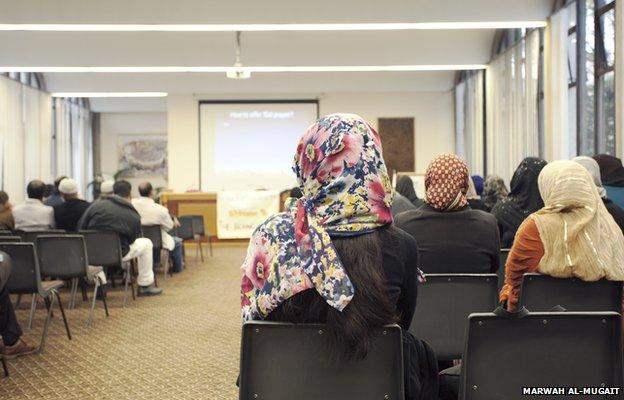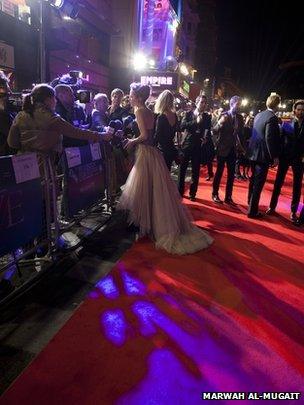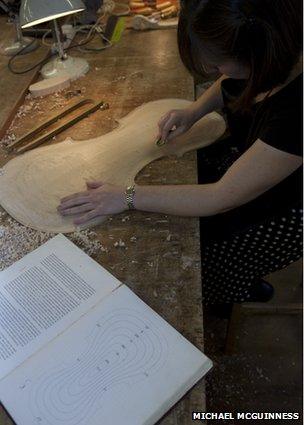Two students seeking an MA: Part II
- Published
- comments

As the end of the year draws near I thought it was time to drop in on Marwah Al-Mugait and Michael McGuinness, the two students I am following as they undertake a year long MA in photojournalism at the University of Westminster.
Alongside the theoretical work led by Dr David Campany they have been producing pictures for two modules.
The first requires the students to produce eight pictures, each on a set theme, which include; action, emotion, indoor portrait and film premier.
It is a tough challenge, and one where the photography is not the only requirement. Each student has to work within their home postcode for all the pictures, except the premier. They are tasked with finding suitable subjects and stories, and then capturing a compelling picture. Yes, to be a photojournalist you have to be able to take great pictures, but you also have to be able to sniff out stories, make contacts, and push your luck and nose in to places.
The other module looks at the production of a photo essay, a sequence of pictures that tell a story backed up by substantial captions.
From my point of view this is welcome news. We get sent many quality photographs that fall flat once we examine the captions. Yes, a caption needs to convey the basics - who, what, where and when; yet for an essay, or feature, you need far more, such as a decent idea for a start. But you also need facts and figures, context and ideally quotes from those in the pictures.
So getting back to the students, what have they achieved since I last spoke to them?
Marwah and Michael have very different backgrounds and yet each has undergone a change of sorts.
On meeting Marwah, I can see the change immediately. She seems far more settled than last time and eager to talk about her work.
Marwah is from Saudi where her photography was studio-based, something that gave her total control. Here, the challenge is to work on the street, or to enter the space of her subject, or even to capture them on the fly.

"I'm much more confident now, particularly in approaching people," said Marwah. "I am a very shy person and used to have people come to me in my studio, now I go to them. It's a quantum leap for me as I now have the whole world in which to create, not just my own little room. I used to manipulate a lot, but now I have lots of people and features to choose from."
Marwah's style is evolving too. Her previous work had a fashion aesthetic and this is now edging towards the documentary feel. "I frame differently now," Marwah told me. "I used to just focus on the face, but now I want a large frame to show details in the background."
It is something that comes with confidence and an understanding of how we communicate visually, moving away from the instant gratification of a bright glossy close up.
Marwah's photo essay is an intriguing one. She is documenting women who have recently converted to Islam. She has found a number of willing participants and pictured them in their own space as well as at morning prayer.

Coming from Saudi the idea of conversion is not something Marwah has experienced before. "I have never interacted with people who have converted to Islam. For them mentally it is not easy, it is a radical change for anyone, especially so for ladies," she said.
The portraits retain Marwah's soft style, and one stands out when the story behind it is explained. It is the details within the picture that reveal the importance of context and captions.
The photograph shows a Japanese woman at a meeting of the Islamic Circle (above), Marwah explains: "This lady is hesitating as to whether to join Islam and be Muslim or not. You can see that because her hair is still showing, a small piece outside of her scarf. It is not fully covered, representing second thoughts."
Now to some this might be obvious, for me though it changed my reading and viewing of the picture.
Perhaps Marwah's biggest challenge came when shooting pictures at a film premier where she joined fans hoping to catch a glimpse of Madonna and other stars at the London premier of W.E. "People are crazy," Marwah said. "I was analysing the crowd, there is a psychology to it as they wait for their idol…I'd never seen this, people filming themselves."
Marwah's pictures capture some of this, the expectation of the crowd, and in one shot she seems to be on the red carpet alongside actress Andrea Riseborough who plays Mrs Simpson in the film. Marwah agreed: "It was a new experience for me, I didn't think I be there, not in my wildest dreams."

Film fans wait to catch a glimpse of the stars at the London premier of W.E.
For Michael it has been a different journey, one that many will experience when beginning a photographic degree or higher level course.
"What's changed for me is that I am taking a more considered approach and asking myself why am I pushing the shutter button," Michael said. "Is the picture viable and valuable? The course has sharpened me up, and I now ask what am I looking for in the picture? What do I want the viewer to see?"
Michael's pictures for the essay are on a story that cannot be released yet, so you will have to wait for that one. But one of his images for the themed module shows the inside of a workshop where musicians can go and make their own instruments.

A violinist gets to work on her instrument
You can see Michael is still exploring the subject, working out what works and what is required to tell the story. He said he also plans to shoot more formal portraits of the musicians with their violins at the various stages of construction.
His interior portrait shot (below), another of the required themes, is inspired by the work of Chauncey Hare, external whose book Interior America explores the spaces in which we live and their effect on our lives.
Hare often used harsh lighting, though Michael's is a subtler mix of daylight and flash, yet the picture pulls us in. If for no other reason than to wonder how anyone can have such a tidy kitchen.
Michael also took to the red carpet as instructed and managed to get a powerful shot of actor Jude Law who seems isolated from those around him (photo top of page).
Michael has also continued a number of personal projects and attended a vast number of photographic seminars and opening nights. You name it, he was probably there. He also visited Photo Paris where he shot a picture on the train en-route, a frame that now features on the New York Times' Lens blog, external.
He is also exploring which equipment he likes to use, hiring the digital Hassleblad from the university and finding that it seems to suit his needs. "As MA students we can borrow kit so I've tried the film and digital Hassleblad," he told me. "I find the film one hard to use but am determined to master the digital version, working with the whole setup and software as well. I didn't connect with the software that came with it, but the Photoshop plug-in seems to suit me more."

Michael's interior portraits are inspired by the work of Chauncey Hare
One thing they both agree on is the need to keep re-visiting subjects and places, to go deeper into a story. "I felt that my early pictures were snapshots," said Marwah. "Now I sense that you have to go and create the story, to interact more with the people. Shifting from a snapshot to something deeper is essential."
This is obviously just a taster of what they have been up to as all their work has to be backed up with detailed written accounts, critical analysis and work books and all the modules explore other issues, such as ethics, picture editing, digital workflow, commercial outlets and much more.
We'll catch up with Marwah and Michael in the New Year.

Michael is also working on a number of self-initiated projects, such as one set in Covent Garden that looks at single spaces throughout the day and is primarily shot on a mobile phone